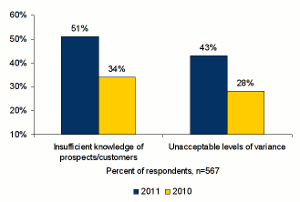
Sales have traditionally been considered an art, science or a mix of both for most practitioners and businesses. Aside the different views on each end of the spectrum; the truth is that Sales is a data-driven function. Performance of each sales rep and organization can be monitored, measured and assessed with data.
In April of 2011 and April and May of 2010, Aberdeen surveyed more than 600 end-user organizations for its pending July 2011 publication on sales forecasting. The results indicate that performance in improving sales forecast accuracy decreased by an average of 79 percent (2011: 0.6 percent improvement vs. 2010: 2.7 percent), pushing companies under increasing pressure of unacceptable variances making it hard to manage their businesses.
Business Context
The ability to understand the specific needs of prospects and customers is critical for most organizations. It enables businesses to offer the most relevant products and services to its customers at the right time with the right message. It also impacts sales forecasting efforts by supporting companies with the ability to determine the likelihood of deals within the sales pipeline to close.
Capturing and managing customer data is a primary challenge stated by 50 percent more businesses in 2011, compared to 2010 — Figure 1. Another challenge expressed by more companies over the previous year is variance — businesses are increasingly challenged with effective use of data to estimate their future revenue.
Aberdeen’s research shows that in order to address these pressures, businesses are reconsidering who manages sales data for forecasting purposes and how.
The first element of change is on who collects data and prepares sales forecasts. As reflected by Aberdeen’s 2010 Sales Forecasting research, 52 percent of the companies delegated Finance, Corporate Operations or Sales Operations the responsibility to publish and distribute sales forecasts. Survey results from the subsequent 2011 research on the topic shows that this number has decreased by 31 percent over the past 12 months to 36 percent. Sales leadership is stated by 53 percent more companies as the primary role taking sales forecasting responsibility, compared to previous year.
Who’s Job?
Reconsidering the role(s) responsible from collecting data and publishing forecasts is only a part of the effort by most companies to improve the effectiveness of their data management practices, thus selling effectiveness.
The second and most crucial aspect is establishing and using business processes to capture and manage data for sales. Research shows that reliance on customized data integration between sales and other information silos (i.e. customer service) have decreased by 2.23-times over the past 12 months. As a result, companies are relying more on IT support compress large volumes of data into a simplified, “C-suite” view of sales forecasts (2011: 62 percent vs. 2010: 42 percent).
Integration forecasting workflow into customer relationship management (CRM) or sales force automation (SFA) systems is another area that 37 percent more businesses are focusing on. Involving IT as a strategic partner in this initiative is instrumental in streamlining the forecasting workflow integration process.
While the aforementioned processes are key ingredients of companies’ efforts to manage sales data and improve sales forecasting performance, use of technology to implement and support those processes has also increased over the past year. Sixty-three percent of the companies participating in the 2011 study indicated that they are using sales analytics/forecasting software to measure data to assess existing sales performance and predict future results, compared to 46 percent in 2010.
In Conclusion
The role of information on enabling businesses to maintain their competitive edge in today’s marketplace is clear — 63 percent of the more than 1,500 executives participating in Aberdeen’s Q4 2010 Quarterly Business Review study indicate that data and business process management tools will consume the most internal resources in 2011.
In order to improve their ability to monitor, measure and predict sales performance, implementing business processes and technologies is critical for most companies. Sales leaders, who are now responsible from forecasting efforts in more than half of businesses, should work collaboratively with IT to implement tools and processes that simplify and improve existing processes to capture and manage data. This will support them in achieving performance results similar to top performers in measures such as overall quota attainment, average sales cycle and annual revenue.
















































Social CRM
See all Social CRM